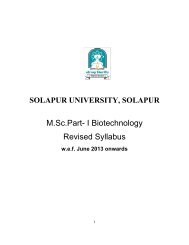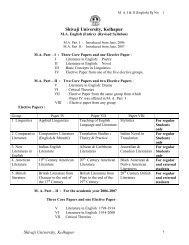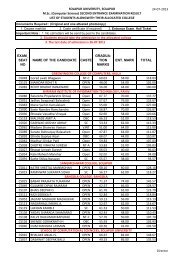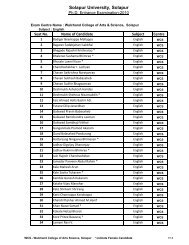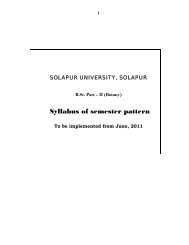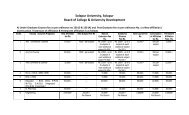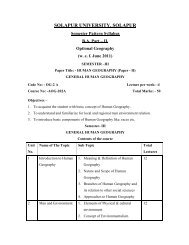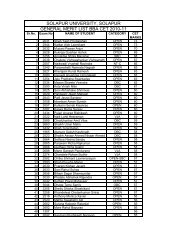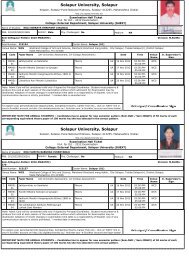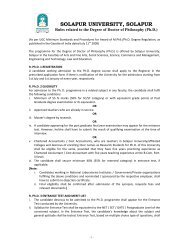Biotechnology - Solapur University
Biotechnology - Solapur University
Biotechnology - Solapur University
Create successful ePaper yourself
Turn your PDF publications into a flip-book with our unique Google optimized e-Paper software.
6Suggested Readings:1) Lehninger’s Principles of Biochemistry by D. L. Nelson and M. M. Cox,CBS Publications, 20002) Biochemistry by Lubert Stryer, 4 th Edition3) Biochemistry by Zubay4) Biochemistry By Garrett and Grisham5) Complex Carbohydrate by Nathan SharonMBT 104: Biostatistics and Bioinformatics with Computer Orientation(60 lectures)UNIT I (15)BASIC TERMS, MEASURES OF CETRAL TENDENCY AND DISPERSION:Population, Sample, variable, parameter, primary and secondary data, screening andrepresentation of data. Frequency distribution, tabulation, bar diagram, histograms,pie diagram, cumulative frequency curves. Mean median, mode, quartiles andpercentiles, measures of dispersion: range, variance, standard deviation, coefficientof variation, symmetry: measures of skewness and kurtosisPROBABILITY AND DISTRIBUTIONS:Sample space, events, equally likely events. Definition of probability (frequencyapproach), independent events. Addition and multiplication rules, conditionalprobability, Examples Bernoulli, Binomial, Poisson and Normal distributions. Meanand variance of these distributions (without proof). Sketching of p.m.f. and p.d.f.,Use of these distributions to describe in biological models. Models sampling andSimulation study.UNIT II (15)BIVARIATE DATA:Scatter plot, correlation coefficient (r), properties (without proof), Interpretation ofr, linear regression. Fitting of lines of regression, regression coefficient, coefficientof determination.METHODS OF SAMPLING:Use of random numbers to generate simple random samples with replacement andwithout replacement. Sampling distribution and standard deviation of sample mean.Stratified sampling and its advantages.HYPOTHESIS TESTING:Hypothesis, critical region, and error probabilities. Tests for proportion, equality ofproportions, equality of means of normal populations when variance known andwhen variances are unknown. Chi-square test for independence. P-value of thestatistic. Confidence limits, Introduction to one way and two-way analysis ofvariance.6
88) Determination of fructose concentration by resorcinol method.9) Estimation of DNA and RNAa) Estimation of DNA by diphenyl amine method.b) Estimation of DNA by Spectrophotometric method.c) Estimation of RNA by orcinol method.10) Estimation of Cholesterol11) Estimation of Inorganic phosphate by Fiske & Subbarow Method12) Estimation of Vit. C concentration by DCPIP method13) Isolation of Characterization of casein from milk.14) Isolation and characterization of starch from potato.15) Isolation of DNA and RNA.16) Isolation of cholesterol and lecithin from egg yolk.17) Determination of hyperchromicity and study of melting curves.MBTPr 102: Laboratory Course II (60 lecturers)Biostatistics and bioinformatics:1) Measures of Central Tendency and Dispersion2) Statistical Analysis using EXCEL (Descriptive statistics and graphical presentation.)3) Sketching of pmf/pdf of Binomial, Poisson and Normal distributions.4) Correlation and Regression Analysis5) Simple random sampling and stratified sampling.6) Hypotheses testing and confidence intervals.7) Analysis of Variance.8) Word processing.9) Getting an amino acid sequence, nucleotide sequence and blasting.10) Multiple sequence alignment11) Homology modelling12) Structure analysis: secondary, tertiary and Quaternary structure, bond angle, bondlength, different interactions.13) Searching for possible ligand, ligand protein interactions.14) Primer designing.15) Phylogenetic studies.Suggested Readings:1) Practical Biochemistry: An Introductory Course by Fiona Frais.2) Methods in Enzymology Vol. I by S.P.Colowick and N.O.Kaplan eds.3) Basic Biochemical Methods 2 nd ed. by R.R. Alexander and J.M.Grilffith4) Biochemical Methods 2 nd ed. by S.Sadasivam and A. Manickam5) Hawk’s Physiological Chemistry ed. by Bernard L Oser.6) A Textbook of Practical Biochemistry by David Plummer.7) Laboratory Mannual in Biochemistry by S. Jayaraman.8
9<strong>Solapur</strong> <strong>University</strong>, <strong>Solapur</strong>,SyllabusM. Sc. Part I (<strong>Biotechnology</strong>), Semester IIMBT -201 -EnzymologyMBT -202 -Molecular BiologyMBT -203 -BioenergeticsMBT -204 -Tools and Techniques in BiosciencesMBT –PR 201 -Laboratory Course IIIMBT –PR 202 -Laboratory Course IV9
10SEMESTER- IIMBT 201 Enzymology 60UNIT IENZYMES:Classification - IUB system, rationale, overview and specific examples.Characteristics of enzymes, enzyme substrate complex. Concept of activecentre, binding sites, stereospecificity and ES complex formation. Effect oftemperature, pH and substrate concentration on reaction rate. Activationenergy. Transition state theory.15ENZYME CATALYSIS:Factors affecting catalytic efficiency - proximity and orientation effects,distortion or strain, acid - base and nucleophilic catalysis. Methods forstudying fast reactions. Chemical modification of enzymes. Isoenzymesand multiple forms of enzymes.UNIT IIENZYME KINETICS:Michaelis - Menten Equation - form and derivation, steady state enzymekinetics. Significance of Vmax and Km. Bisubstrate reactions. Graphicalprocedures in enzymology - advantages and disadvantages of alternateplotting. Enzyme inhibition - types of inhibitors - competitive, noncompetitive15and uncompetitive, their mode of action and experimentaldetermination. Enzyme activity, international units, specific activity,turnover number, end point kinetic assayUNIT IIISTRUCTURE FUNCTION RELATIONS:Lysozyme, ribonuclease, trypsin, carboxypeptidase, phosphorylase,aspartate transcarbamylase, glutamine synthetase and phosphofructo 15kinase. Multi enzyme complexes - pyruvate dehydrogenase and fatty acidsynthetase; Na - K ATPase.UNIT IVALLOSTERIC INTERACTIONS:Protein ligand binding including measurements, analysis of bindingisotherms, cooperativity, Hill and Scatchard plots and kinetics of allostericenzymes.ENZYME REGULATION:Product inhibition, feedback control, enzyme induction and repression andcovalent modification. Allosteric regulation.IMMOBILIZED ENZYMES:15Relative practical and economic advantage for industrial use, effect ofpartition on kinetics and performance with particular emphasis on chargeand hydrophobicity (pH, temperature and Km). Various methods ofimmobilization - ionic bonding, adsorption, covalent bonding (based on Rgroups of amino acids), microencapsulation and gel entrapment.Immobilized multienzyme systems Biosensors - glucose oxidase,cholesterol oxidase, urease and antibodies as biosensorsReferences: -1) Fundamentals of Enzymology- Price and Stevens2) Enzymes -Dixon and Webb3) Isoenzymes By D. W. Moss4) Immobilized Biocatalysts- W. Hartneir5) Selected papers Allosteric Regulation -M. Tokushige6) Enzymes: Biochemistry, <strong>Biotechnology</strong> and Clinical Chemistry, TrevorPalmer, (2004)10
11MBT 202 Molecular biology 60Genome organizationOrganization of bacterial genome, Structure of eucaryotic chromosomes;role of nuclear matrix in chromosome organization and function, matrixbinding proteins, heterochromatin and euchromatin, molecularUNIT Icomponents, DNA reassociation kinetics (Cot curve analysis), repetitiveand unique sequences, kinetics and sequence complexities, satellite 15DNA, DNA melting and buoyant density, packing and organization ofchromatin, nucleosome phasing, DNase I hypersensitive regions, DNAmethylation & Genetic Imprinting, Mutation; Nonsense, missense andpoint mutations, intragenic and intergenic suppression,frameshiftmutations, physical, chemical and biological mutagens.UNIT IIDNA Replication, Repair & RecombinationConcepts of replication initiation (Replicon), elongation and termination inprokaryotes and eukaryotes, enzymes and accessory proteins involved inDNA replication, Fidelity in replication, replication of single strandedcircular DNA. Gene stability and DNA repair, DNA repair enzymes,photoreactivation, Base excision repair, mismatch repair, methyl mediatedmismatch repair (MMR), SOS repair. Recombination: homologous –Generalized (Prophase, synaptonemal complex with evidences in 15recombination), site specific (FLP/FRT and Cre/Lox recombination RecAand other recombinases). and non-homologous recombination –Transposons as illegitimate recombination agency, μU transposon,retroposon, conservative, replicative transposition. Holliday structure,resolution of holiday junction, chi sequences in prokaryotes, recBCDPathway, gene targeting, gene disruption. Bacterial geneticrecombination: Transformation, Conjugation, Transduction.UNIT IIIProkaryotic & Eukaryotic TranscriptionProkaryotic Transcription & Regulation: Promoters (WRT –various sigmaspecificity), Regulatory elements, Transcription unit, constitutive andinducible promoter, operators, Initiation, Termination, Rho-dependent andindependent termination, Anti-termination, Transcriptional regulation,Operon concept; Positive (the ara operon) and Negative (the lacoperon), Attenuation (the trp operon), transcriptional control in lambdaphage –Genetic switch wrt Lysogeny /Lytic control, the mRNAProcessing- 3’ end formation, capping and splicing, Processing of tRNA15and rRNA Eucaryotic Transcription and regulation: RNA polymerasestructure and assembly, RNA polymerase I, II, III, Eukaryotic promotersand enhancers, General Transcription factors, TATA binding proteins(TBP) and TBP associated factors (TAF), Activators and repressors,transcription initiation, elongation and termination, activation andrepression, Transcriptional and post-transcriptional gene silencing,expression Nuclear export of mRNA, mRNA stability, catalytic RNA.Translation & Transport –Prokaryotic and EukaryoticThe translation machinery, ribosomes, composition and assembly,Universal genetic code, degeneracy of codons, termination codons,UNIT IV isoaccepting tRNA, wobble hypothesis. Mechanism of initiation, 15elongation and termination, Co- and post-translational modifications,genetic code in mitochondria. Protein synthesis, Transport of proteins andmolecular chaperones, protein stability, protein turnover and degradation11
12References:-1. Stryer L (1995) Biochemistry, 4 th edition, W. H. Freeman & company.2. Watson J. D., Hopkins, N. H., Roberts, J. W., Steitz, J. A. and Weiner,A. M. (1988) Molecular biology of the gene, 4 th edition, Pearson(publisher)3. Benjamin Lewin (1999) Genes IX or X, oxford <strong>University</strong> Press, Oxford.4. Weaver R. F. (1999) Molecular biology, WCB McGraw-Hill companies, I5. Brown T A (1995) Essential molecular biology, vol. I, A practicalapproach.6. Genes and Genomes -Maxine Singer and Paul Berg,7. Microbial Genetics –David Freifelder, J. E. Cornan, S. R. Maloy, (1994),Jones and Bartlett Learning publisher.12
13MBT 203 Bioenergetics 60UNIT IFREE ENERGY CONCEPT:Molecular basis of entropy, concept of free energy, standard free energyand measurement of free energy, significance in metabolism. Applicationof first and second law of thermodynamics to biological systems. Energyrich bonds - ATP and interconversions of nucleotide phosphates.Phosphorylation potentialNITROGEN FIXATION:Biological fixation of nitrogen- symbiotic and non-symbiotic. Nitrogenaseenzyme complex - azoferredoxin and Molybdoferrodoxin. Physiologicalelectron donors and mechanism of nitrogen reduction, assimilation ofammonia, nitrogen cycle. nif genes and its regulation (Klebsiella andRhizobium).15UNIT IIUNIT IIIUNIT IVMITOCHONDRIA:Architecture, chemical activity of mitochondria. Sequence of electroncarriers and sites of oxidative phosphorylation, ATP generation, heme andnon- heme iron proteins. Thermodynamic considerations, oxidation -reduction electrodes, standard electrode potential, redox couples,phosphate group transfer potential. Respiratory controls. Theories ofoxidative phosphorylation, uncouplers and inhibitors of energy transfer.ATP synthetase complexCHLOROPLAST:Architecture, - light harvesting complexes, bacteriorhodopsin,plastocyanin, carotenoids and other pigments. Hill reaction, photosystem Iand II - location and mechanism of energy transfer, photophosphorylationand reduction of carbon dioxide. Calvin cycle, quantitative efficiency,photorespiration, C4 - metabolism. Chemiosmotic theory and evidence forits occurrence, ion transport through membranes, proton circuit andelectro-chemical gradient, ionophores, Q cycle and stoichiometry ofProton extrusion and uptake, P/O and H/P ratios, reverse electrontransfer. Fractionation and reconstitution of respiratory chain complexes.HORMONES :General classification of hormones - synthesis, structure, secretion,transport, metabolism and mechanism of action of pancreatic, thyroid,parathyroid, hypothalamus, pituitary, adrenal and prostaglandins.Hormonal control of spermatogenesis, menstrual cycle,Pregnancy and lactation. Cell membrane and intracellular receptors forhormones. Secondary messengers Plant growth hormones - auxins,gibberllins, abscessic acid, cytokinins. PhenoromonesReferences:-1. Biochemistry by Lubert Stryer 4th Edition2. Biochemistry by Mathew VanHolde3. Lehningers Principles of Biochemistry by Nelson and Cox4. Hormones by Norman Litwack5. Basic and Clinical Endocrinology- Greenspan and Baster6. Biochemistry and Physiology of Plant Hormones- Thomas Moore7. Annual Review of Biochemistry 19778. Thermodynamics for Biological Systems -Baine15151513
14MBT 204 Tools and Techniques in Bioscience 60UNIT ITECHNOLOGY FUNDAMENTALS (Life Science):General scheme for purification of bio-components. Methods for studyingcells and organelles. Sub-cellular fractionation and marker enzymes.Methods for lysis of plant, animal and microbial cell. Ultra filtration, freeze15drying and fractional precipitation. Use of detergents in isolation ofmembrane proteins.UNIT IICHROMATOGRAPHY:Basic principles and applications of ion-exchange, gel filtration, partition,affinity, HPLC and reverse phase chromatography, gas chromatography,TLC and HPTLC, Paper chromatography. Chromatofocussing.15CENTRIFUGATION:Ultracentrifugation - velocity and buoyant density determination. Densitygradient centrifugation, molecular weight determination.UNIT IIIELECTROPHORESIS:Basic techniques, poly acrylamide/ starch/ agarose gel electrophoresis,use of SDS/urea, isoelectric focusing, capillary electrophoresis. Pulse fieldgel electrophoresis.TRACER TECHNIQUES:15Principles and applications of tracer techniques in biology, Measurementof alpha, beta and gamma radiations. Radiation dosimetry, Radioactiveisotopes and half life of isotopes, Autoradiography, Cerenkov radiation,Liquid Scintillation spectrometry.UNIT IVDETERMINATION OF BIOPOLYMER STRUCTURE (Principles andapplications): X-ray diffraction, fluorescence, UV, visible, CD/ORD, ESR,NMR and Mass spectroscopy, atomic absorption spectroscopy. Plasmaemission spectroscopy.15MICROSCOPY:Principles and application of light , phase contrast, fluorescence, scanningand transmission electron microscopyReferences:-1) Protein Purification by Robert Scopes, Springer Verlag Publication,19822) Tools in Biochemistry David Cooper3) Methods of Protein and Nucleic acid Research, Osterman Vol I – III4) Centrifugation D. Rickwood5) Practical Biochemistry, V th edition, Keith, Wilson and Walker.6) Plant Drug Analysis: A Thin Layer Chromatography Atlas, HidelbertWagner and Sabine Bladt. Springer –Verlag –2 nd Edition (2009).14
15MBT PR201MBT PR202Laboratory Course III1] Separation and identification of amino acid mixture byi] Paper chromatography technique.ii]Paper electrophoresis technique2] Thin layer chromatographic separation of sugars and membrane lipids.3] Separation and identification of serum proteins bypolyacrylamide/agarose gel electrophoresis. (BSA/Hb).4] Separation of DNA by agarose gel electrophoresis.5] Separation of proteins (hemoglobin & cytochrome c) using molecularsieve chromatography.6] Determination of capacity of ion exchange resin [Dowex- 50]7] Purification of protein by ion exchange chromatography.[DEAE cellulose chromatography]8] Determination of activity of invertase from immobilizedcells of Saccharomyces cerevisiae9] Determination of Reassociation kinetics of genome10] Dark Repair, Photoreactivation11] Bacterial Transformation12] Bacterial ConjugationLaboratory Course IV1. Identification and quantitation of activity of :Amylase/cellulase/amyloglucosidase/invertase/alkaline phosphatase(salivary/microbial/animal/plant source]2. Determination of specific activity.3. Determination of activity in presence of activators.4. Determination of activity in presence of inhibitors.5. Determination of optimum pH6. Determination of optimum temperature7. Determination of Km/ Vmax8. Determination of Competitive, non-competitive inhibitorsReferences:-1) Methods in Enzymology Vol. I and II by S.P.Colowick andN.O.Kaplan eds.2) Basic Biochemical Methods 2nd ed by R.R.Alexander andJ.M.Griffith.3) Hawk’s Physiological Chemistry ed. by Bernard L Oser.4) A Textbook of Practical Biochemistry by David Plummer.5) Laboratory Mannual in Biochemistry by S. Jayaraman.6) Practical Biochemistry by Clarke and Switzer7) Methods in Enzymatic analysis by Bergmeyer, Vol I – III15



